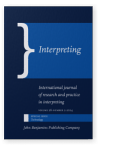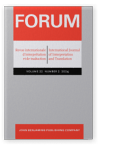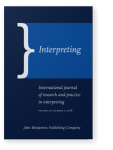Chao Han
List of John Benjamins publications for which Chao Han plays a role.
Journal
2024 Evaluating written versus audio feedback in formative assessment of consecutive interpreting: An exploratory qualitative investigation FORUM 22:2, pp. 182–205 | Article
In formative assessment, teacher feedback can enhance student learning. To reap such benefits, educators need to deliver feedback in such a way that arouses students’ learning interest, invites their active engagement, and inspires follow-up action. We report on an exploratory qualitative study… read more
2023 Relating utterance fluency to perceived fluency of interpreting: A partial replication and a mini meta-analysis Translation and Interpreting Studies 18:3, pp. 421–447 | Article
The prospect of automated scoring for interpreting fluency has prompted investigations into the predictability of human raters’ perceived fluency based on acoustically measured utterance fluency. Recently, Han, Chen, Fu and Fan (2020) correlated ten utterance fluency measures with raters’… read more
2023 An item-based, Rasch-calibrated approach to assessing translation quality Target 35:1, pp. 63–96 | Article
Item-based scoring has been advocated as a psychometrically robust approach to translation quality assessment, outperforming traditional neo-hermeneutic and error analysis methods. The past decade has witnessed a succession of item-based scoring methods being developed and trialed, ranging from… read more
2023 Effects of language background and directionality on raters’ assessments of spoken-language interpreting Revista Española de Lingüística Aplicada/Spanish Journal of Applied Linguistics 36:2, pp. 556–584 | Article
Bilingual raters play an important role in assessing spoken-language interpreting (between X and Y languages). Presumably, raters with X being the dominant language (DL) and Y the less DL can potentially differ, in terms of rating processes, from other raters with Y being the DL and X the less… read more
2023 Use of statistical methods in translation and interpreting research: A longitudinal quantitative analysis of eleven peer-reviewed journals (2000–2020) Target 35:4, pp. 483–513 | Article
The study reported on in the article examines the patterns and trends of statistical analysis in translation and interpreting (T&I) research, based on a longitudinal quantitative analysis of more than 3300 research articles sampled from eleven leading T&I journals (2000–2020). This… read more
2023 Automatic assessment of spoken-language interpreting based on machine-translation evaluation metrics: A multi-scenario exploratory study Interpreting 25:1, pp. 109–143 | Article
Automated metrics for machine translation (MT) such as BLEU are customarily used because they are quick to compute and sufficiently valid to be useful in MT assessment. Whereas the instantaneity and reliability of such metrics are made possible by automatic computation based on predetermined… read more
2022 Assessing spoken-language interpreting: The method of comparative judgement Interpreting 24:1, pp. 59–83 | Article
In this study, we applied and evaluated a scoring method known as comparative judgement to assess spoken-language interpreting. This methodological exploration represents an extension of previous efforts to optimise scoring methods for assessing interpreting. Essentially, comparative judgement… read more
2021 Assessing the fidelity of consecutive interpreting: The effects of using source versus target text as the reference material Interpreting 23:2, pp. 245–268 | Article
The study reported on in this article pertains to rater-mediated assessment of English-to-Chinese consecutive interpreting, particularly informational correspondence between an originally intended message and an actually rendered message, also known as “fidelity” in Interpreting Studies.… read more
2020 Mariachiara Russo, Claudio Bendazzoli & Bart Defrancq. Making Way in Corpus-based Interpreting Studies FORUM 18:1, pp. 105–110 | Review
2020 Modeling the relationship between utterance fluency and raters’ perceived fluency of consecutive interpreting Interpreting 22:2, pp. 211–237 | Article
Fluency is an important, yet insufficiently understood, construct in interpreting studies. This article reports on an empirical study which explored the relationship between utterance fluency measures and raters’ perceived fluency ratings of English/Chinese consecutive interpreting. It also… read more
2018 Using rating scales to assess interpretation: Practices, problems and prospects Interpreting 20:1, pp. 63–101 | Article
Over the past decade, interpretation assessment has played an increasingly important role in interpreter education, professional certification, and interpreting research. The time-honored assessment method is based on analysis of (para)linguistic features of interpretation (including such items… read more
2018 Mixed-methods research in interpreting studies: A methodological review (2004–2014) Interpreting 20:2, pp. 155–187 | Article
Interpreting Studies (IS) has emerged as an interdisciplinary enterprise, using a diverse array of research methods derived from postpositivist and constructivist paradigms to investigate interpreting/translational phenomena. Mixed-methods research (MMR), which should enable both Erklärung… read more
2016 A survey to profile conference interpreting practice in China Interpreting 18:2, pp. 259–272 | Article
This report presents findings from an online survey of 140 English/Chinese conference interpreters, conducted as a follow-up of an exploratory diary study (Han 2015), to provide a detailed account of real-life interpreting practice in China. Three main tendencies are identified: a)… read more
2016 Test validation in interpreter certification performance testing: An argument-based approach Interpreting 18:2, pp. 225–252 | Article
Over the past decade, interpreter certification performance testing has gained momentum. Certification tests often involve high stakes, since they can play an important role in regulating access to professional practice and serve to provide a measure of professional competence for end users. The… read more
2016 Strategy use in English-to-Chinese simultaneous interpreting: A descriptive-exploratory study FORUM 14:2, pp. 173–193 | Article
The study reported here attempts to describe and explore possible patterns of strategy use in English-to-Chinese simultaneous interpreting (SI) of fast-delivery and accented speeches, drawing upon a subset of empirical data generated from a larger experimental study (see Han & Riazi 2016). A… read more
2015 Investigating rater severity/leniency in interpreter performance testing: A multifaceted Rasch measurement approach Interpreting 17:2, pp. 255–283 | Article
Rater-mediated performance assessment (RMPA) is a critical component of interpreter certification testing systems worldwide. Given the acknowledged rater variability in RMPA and the high-stakes nature of certification testing, it is crucial to ensure rater reliability in interpreter certification… read more

















